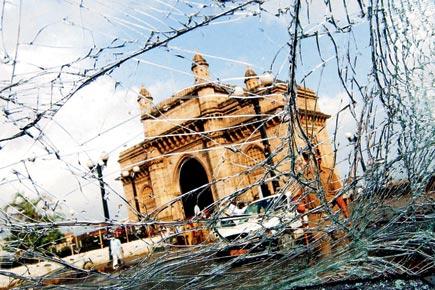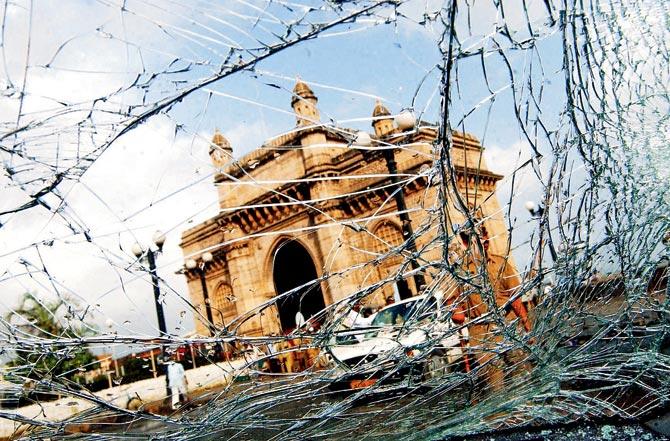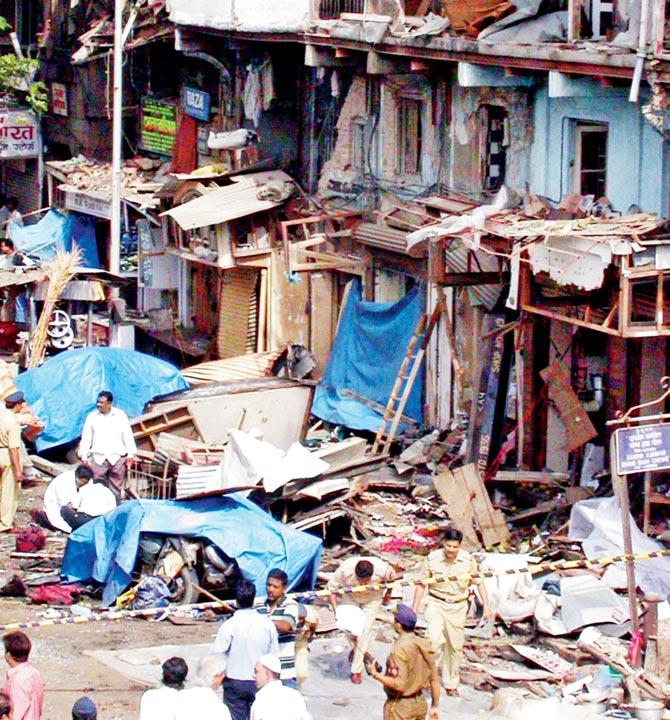In Dangerous Minds, S Hussain Zaidi and Brijesh Singh write about those who spread terror in India. This is the story of Fahmida, who helped orchestrate the 2003 Gateway and Zaveri Bazaar blasts that killed 52 people

 Sixteen died and 46 were injured in the Gateway blasts
Sixteen died and 46 were injured in the Gateway blasts
Since the formation of the group, Hanif acted as the ringleader, Nasir as the resource organiser, and Fahmida played the chief deputy and adviser of the gang. After Zahid called from Dubai and recommended him, Hanif also roped in Ashrat Ansari, an embroidery worker who lived in Juhu Galli and had fled from his workplace in Surat, Gujarat, after hearing of a rampaging mob coming from Ahmedabad towards his city. Zahid found Ashrat to be enthusiastic and trustworthy. Ashrat related more stories about the Gujarat riots, reaffirming everyone's resolution to strike at the earliest. The motley group of people rechristened themselves as the Gujarat Revenge Force (GRF), according to the police charge-sheet in the specially designated Prevention of Terrorism Act (POTA) court.
It took Hanif over three months, since his return from Dubai, to put together the team, gather their wits and wherewithal, and plan a strike. But Fahmida's involvement accelerated their machinations.
They decided to move without fixing any particular date. Ashrat and Hanif made a bomb and placed it on Bus No. 312 at Seepz on 2 December 2002. The bus later changed its number to 336. The bomb was timed to explode at 7 pm, during peak hour. But it was an amateurishly assembled bomb, the wires were meshed, and it failed to explode. The whole GRF team assembled in front of a television to watch the fate of BEST passengers, and were dejected when the bomb was discovered.
 The blast at Zaveri Bazaar killed 36 and left 138 injured. Forty-one shops and houses as well as the area in a 200-metre radius of the cab sustained serious damages
The blast at Zaveri Bazaar killed 36 and left 138 injured. Forty-one shops and houses as well as the area in a 200-metre radius of the cab sustained serious damages
An alert passenger had found the package. Earlier that day, another bomb had exploded on a BEST bus just outside Ghatkopar railway station. However, the bus was empty at that time.
Meanwhile, the Mumbai Central, Vile Parle and Mulund blasts occurred, and the GRF retreated. After a few months, Fahmida was restless, and also unhappy about the poorly constructed improvised explosive device. This time she asked Nasir to make the bomb.
It had been months since their failure. On 25 July, the GRF struck again. Nasir assembled the bomb, and Fahmida decided to place it herself. The bomb was made with forty-four gelatin sticks. Fahmida and Ashrat boarded BEST Bus No. 340 from Andheri, headed towards Ghatkopar. They bought tickets to Asalfa, the arterial road connecting Andheri and Ghatkopar.
But they got a seat earlier than expected, and Fahmida silently slid her bag below the seat, left it there without anyone noticing, and the duo then deboarded at Marol Maroshi Road. Fahmida, having placed a parcel of death under a bus seat, wasn't tense. She did not break a sweat, didn't feel her heartbeat quickening. She would later confess in her statement to the police that she returned home as if an errand had been completed, went to the vegetable market, bought groceries, returned home and cooked the evening meal for her family.
Once again, the group was glued to a television set to assess the extent of damage they had caused: Four dead and sixty injured. It was their first major success. Hanif and Fahmida were elated. Nasir and Ashrat were satisfied too, even though it could have been deadlier. So they decided to ramp up their attack and plan for a bigger kill, but in the meantime they prudently lay low for a few weeks. They did not want to make a hasty move and get arrested.
Nasir suggested that their targets should now be more prominent, to draw international attention. They conducted a recce and decided to change their modus operandi this time, using car bombs instead.
Towards the end of August 2003, Hanif, Nasir and Ashrat spent one night in the loft, diligently assembling the bombs. The Cuban cigar-sized gelatin sticks were fitted with detonators.
The ends were then soldered to two wires that were connected to an alarm clock. The little clock was crucial in the circuitry of the bomb, working as a battery and passing electrical current at the ringing of the alarm. It would electrify the circuit and trigger the detonator. By placing the bomb in the boot right next to the CNG tank, the impact of the explosion would be multiplied manifold, thus turning the whole car into a bomb.
 Fahmida Sayyed
Fahmida Sayyed
Hanif was a trained electrician and he understood wiring and connections to trigger points and detonators, while Nasir was trained to make bombs with gelatin sticks and had now learnt how to amplify the force. On 24 August, Hanif hired taxi driver Shiv Narayan Pandey to take them around the city while they quietly conducted a recce of the spots where they could leave the cab.
The spot they chose was a vantage point to inflict maximum damage. Pandey was paid R1,000 for the tour and asked to come back the next day. On 25 August, Fahmida and Hanif decided to take along their two daughters, sixteen-year-old Farheen and four-year-old Shakira. Shakira did not want to miss school but Fahmida thought it wise to travel as a family to attract minimum attention. The parents placated Shakira by promising to take her to Byculla Zoo.
The unsuspecting cab drivers Shiv Pandey and Lala Singh were happy. Both taxis were hired and the bombs placed in the boot. They were timed to explode at 1 pm. Ashrat sat in Singh's taxi and said he wanted to go to Zaveri Bazaar. Hanif and his family sat in Pandey's cab and left for the Gateway of India.
At Zaveri Bazar, Ashrat pretended to be waiting for someone. After some time, Ashrat asked the driver to park the cab and wait as he wanted to go out and buy some material. He got out and began walking towards Charni Road station, the closest railway station. He had barely walked 200 metres when he heard an explosion. He smiled and looked at his watch. The bomb had exploded at 12.40 pm.
At the Gateway, Hanif asked Pandey to park in a Pay-and-Park enclosure near the seaside parapet just across the Taj Mahal Hotel. Hanif told the driver not to go anywhere as they would return shortly. Instead, the family went straight to a bus stop and boarded a bus towards home.
At 1 pm, Pandey thought he should grab a quick lunch and stepped out of his cab towards a nearby stall. Seconds later, the bomb exploded. Pandey turned and saw his taxi in flames, a huge crater on the pavement near the parapet.
The car behind Pandey's cab was flung 32 feet away. Twenty other cars were damaged. Window panes of the Taj Mahal Palace Hotel and nearby lamp posts were shattered due to the impact.
Sixteen people had died and forty-six were injured. The blast at Zaveri Bazaar was deadlier. It killed thirty six people and left 138 injured. Forty-one shops and houses as well as the area in a 200-metre radius of the cab sustained serious damages.
These two blasts were the biggest successes of the Gujarat Revenge Force, whose members had once again gathered around a television set to assess the extent of damage they had left in their wake.
Neighbours gathered too, discussing how fortunate Hanif's family was to have narrowly escaped death and left the spot only minutes before the blast. Later, they would recall to police officers how they'd found it curious that Hanifs' family appeared to be interested only in the number of casualties, repeatedly discussing how many people had died on the spot.
Excerpted with permission from Dangerous Minds: Eight riveting profiles of homegrown terrorists by S Hussain Zaidi and Brijesh Singh, published by Penguin Random House India
 Subscribe today by clicking the link and stay updated with the latest news!" Click here!
Subscribe today by clicking the link and stay updated with the latest news!" Click here!









